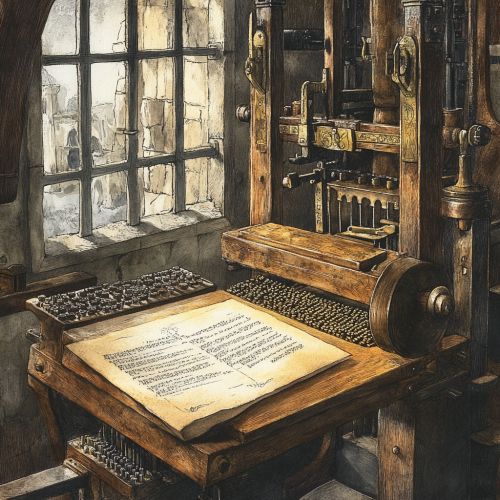Gutenberg Press
Introduction
The Gutenberg press is a pivotal invention in the history of printing and publishing, attributed to the German inventor Johannes Gutenberg. Developed around 1440, this mechanical movable type printing press revolutionized the production of books and other printed materials, significantly impacting the dissemination of knowledge and the spread of literacy. The Gutenberg press is often credited with ushering in the Renaissance, the Reformation, and the Scientific Revolution by making information more accessible and affordable.
Historical Context
Pre-Gutenberg Printing
Before the advent of the Gutenberg press, the primary method of book production in Europe was through manuscript copying by scribes, a labor-intensive and time-consuming process. Block printing, which involved carving entire pages of text and images onto wooden blocks, was also used but was limited by its inefficiency and the rapid wear of the blocks. The concept of movable type had been developed earlier in China and Korea, but it had not been widely adopted in Europe due to various technological and cultural factors.
Johannes Gutenberg
Johannes Gutenberg, born in Mainz, Germany, around 1400, was a goldsmith by trade. His background in metalworking provided him with the skills necessary to develop the movable type system. Gutenberg's innovation lay in creating durable metal type pieces that could be arranged and rearranged to print multiple pages. His press combined elements of existing technologies, such as the wine press, to create a machine capable of producing high-quality printed materials efficiently.
Technical Innovations
Movable Type
The core innovation of the Gutenberg press was the use of movable type. Gutenberg developed a typecasting system that allowed for the mass production of individual letters and characters. These type pieces were made from an alloy of lead, tin, and antimony, which provided the durability needed for repeated use. The movable type system enabled printers to compose and print pages with unprecedented speed and accuracy.
Printing Press Mechanism
The printing press itself was a mechanical device that applied pressure to an inked surface resting on a sheet of paper. Gutenberg adapted the design of the traditional screw press, commonly used in winemaking, to create a press that could evenly distribute pressure across the page. This innovation ensured consistent print quality and reduced the time required to produce each page.


Ink and Paper
Gutenberg also developed a new oil-based ink that adhered better to metal type and paper than the water-based inks previously used. This ink was crucial for producing clear and durable prints. The paper used in the Gutenberg press was typically made from linen rags, which provided a smooth surface for printing and absorbed the ink effectively.
Impact on Society
Dissemination of Knowledge
The Gutenberg press dramatically increased the availability of books and other printed materials, reducing their cost and making them accessible to a broader audience. This democratization of knowledge facilitated the spread of new ideas and contributed to the intellectual and cultural movements of the time. The press played a significant role in the Protestant Reformation, as it enabled the rapid dissemination of Martin Luther's theses and other reformist writings.
Standardization of Texts
The ability to produce multiple copies of a text with consistent content and formatting led to the standardization of texts. This was particularly important for religious and scholarly works, as it ensured that readers across different regions had access to the same information. The Gutenberg Bible, printed in the 1450s, is a prime example of this standardization and is considered one of the most beautiful books ever produced.
Economic and Cultural Effects
The printing industry that emerged from Gutenberg's invention created new economic opportunities and contributed to the rise of a literate middle class. Printers, booksellers, and publishers became important figures in society, and the demand for printed materials spurred advancements in related fields such as papermaking and typography. The cultural impact of the Gutenberg press extended beyond Europe, influencing the development of print cultures worldwide.
Legacy and Influence
Technological Evolution
The principles established by the Gutenberg press laid the foundation for subsequent advancements in printing technology. Over the centuries, innovations such as the rotary press, offset printing, and digital printing have built upon Gutenberg's work, each improving the efficiency and quality of printed materials.
Preservation and Study
Today, the legacy of the Gutenberg press is preserved in museums and libraries around the world. Original copies of the Gutenberg Bible and other early printed works are highly valued for their historical and cultural significance. Scholars continue to study the impact of the Gutenberg press on various aspects of society, exploring its role in shaping modern communication and information dissemination.
Conclusion
The Gutenberg press represents a watershed moment in the history of human communication. By making printed materials more accessible, it transformed the way knowledge was shared and consumed, paving the way for the modern information age. Its influence is still felt today, as the principles of movable type and mechanical printing continue to underpin contemporary publishing practices.
